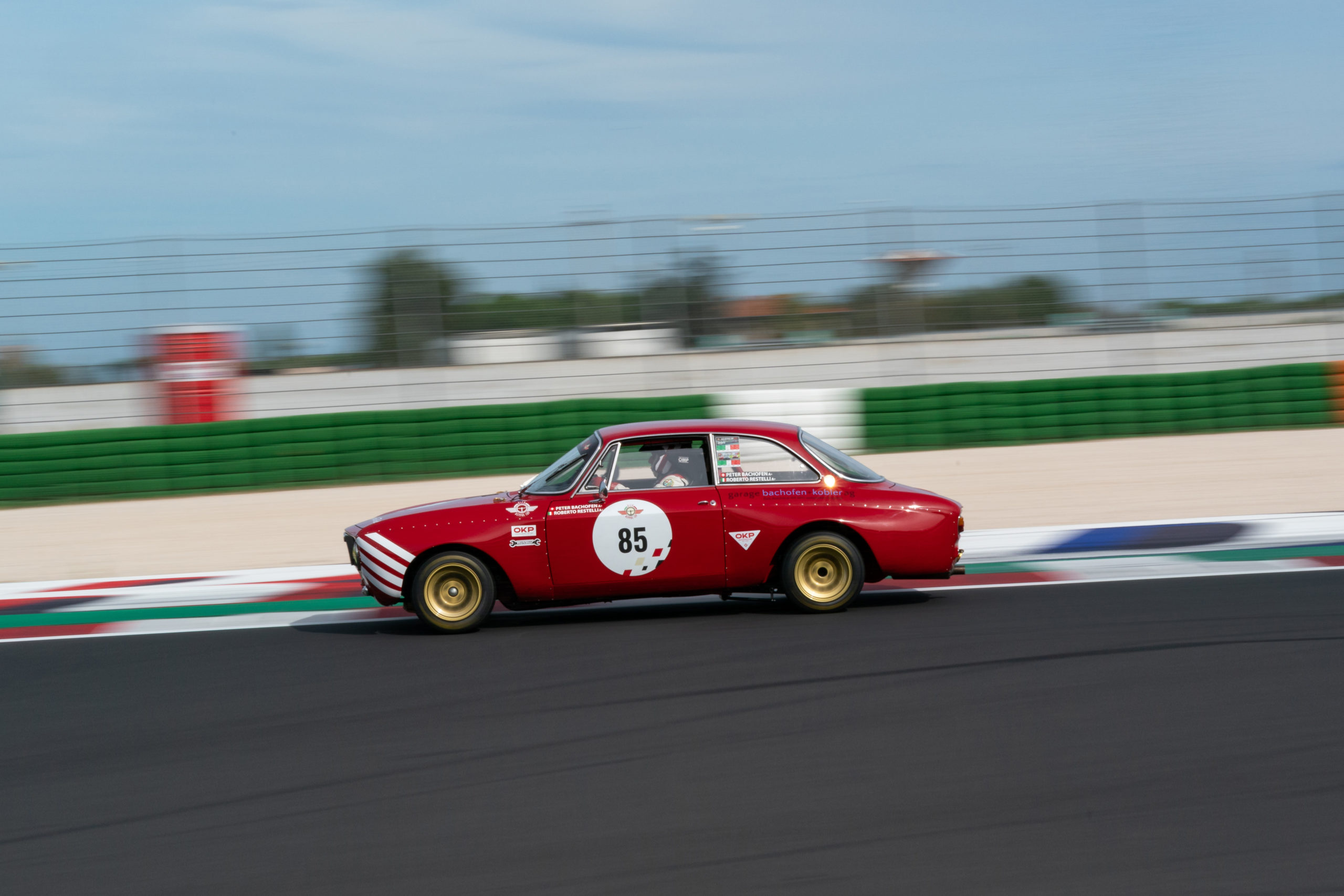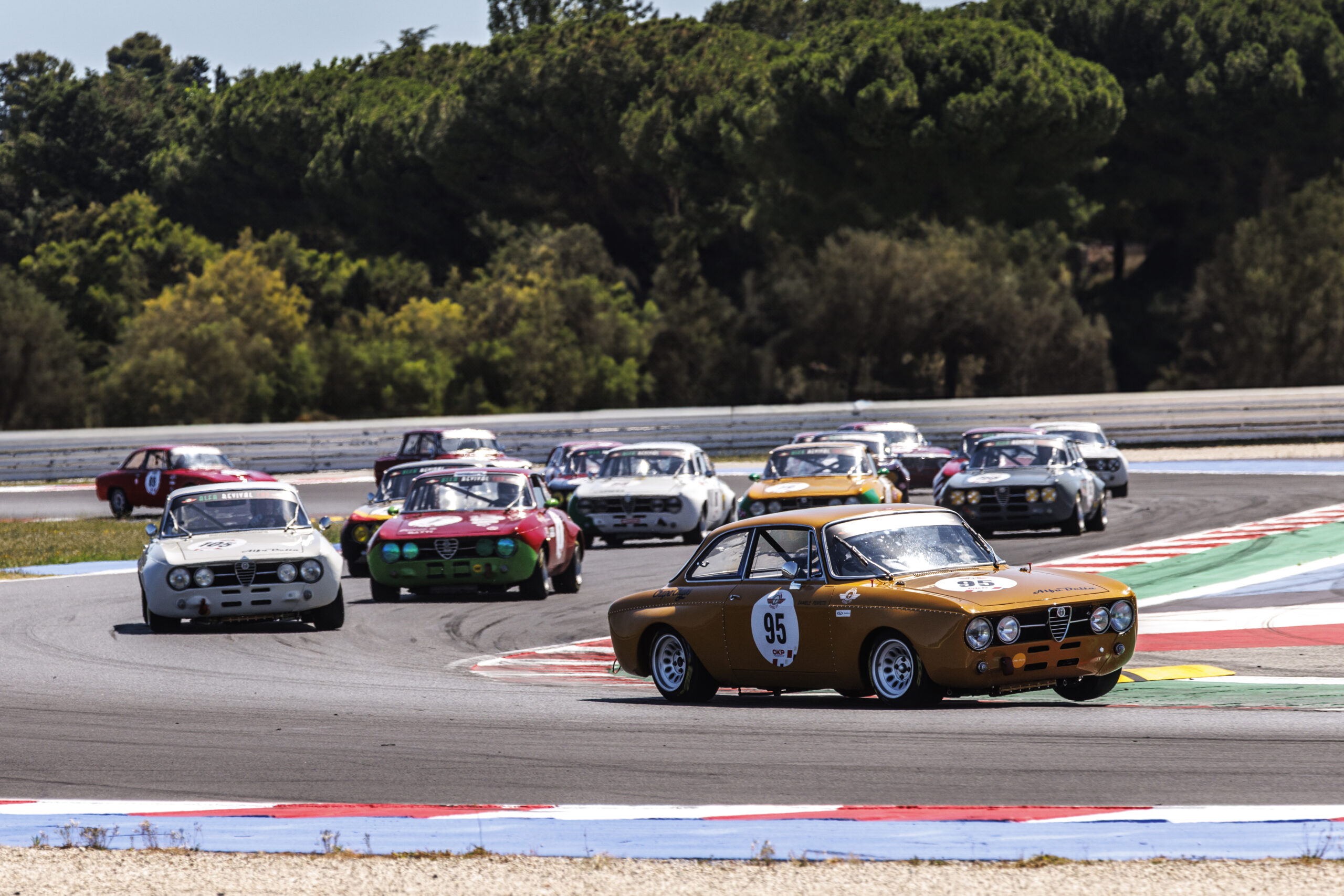December 12, 2023: Driving a beautifully prepared GTAm, Restelli secured second place in the overall Canossa championship standings and won the highly contested G2 TC 2000 category.
A familiar face in the Alfa Revival Cup paddock, Roberto Restelli is the owner of Officina Alfa Delta and a track protagonist, alongside his friend Peter Bachofen. Driving a beautifully prepared GTAm, Restelli secured second place in the overall Canossa championship standings and won the highly contested G2 TC 2000 category.
Roberto shares his sports and professional journey, which transitioned from working with helicopters to founding Officina Alfa Delta in Marnate (Varese), exclusively dedicated to race car preparation.
“I did something completely different before starting this activity. I worked for a helicopter manufacturing company, Agusta. I was an electronic engineer, but I’ve always been extremely passionate about cars, thanks to my father’s influence, a racing and F1 enthusiast. This passion led me to a situation where I worked during the day at Agusta and in the evenings went to Chiapparini, a well-known preparer, to lend a hand in the workshop. This was in ’96/’97. I started going to him purely out of passion, not seeing it as a job. From a brief presence, the collaboration expanded, and I began going to the workshop every evening, on Saturdays, Sundays, during summer vacations, and to the races.”
Your passion was total, and did you also gain some experience as a driver?
“I participated in races that were inexpensive because I didn’t have a budget. I was just over twenty, racing with a Uno Turbo in slaloms and Formula Rally.”
With Chiapparini, were you already involved in historic races on the track?
“Yes, Chiapparini raced these cars, GTA and GTAm. He always had cars from the ’70s, when they were current, and continued racing them even as they became historic. The more time I spent in the workshop, the more passionate I became. My presence in the workshop became more intense; I tested engines on the dyno early in the summer mornings, then went to the office and returned to the workshop after work at Agusta. At one point, Chiapparini told me he wanted to retire and suggested I take over, while he remained involved. When we finally managed to make this happen after some time, unfortunately, Chiapparini passed away.”
It was a tough blow, both emotionally and professionally. It could have made you give up, but instead?
“For me, he was like a father, and we had a certain kind of relationship. I couldn’t bring myself to do something like that without him. At this point, I started working in my home garage, and during this phase, old clients sought me out. So, I took a small workshop where I continued working part-time. At that point, some friends and clients who are still with me convinced me to leave the job at Agusta and dedicate myself entirely to the preparation workshop. In 2013, Officina Alfa Delta was born, and I became the dealer for OKP in Italy.”
Do you work only on race cars?
“In my workshop, I only do race cars and some particular restorations, exclusively for the Alfa Romeo brand. The clientele gradually grew, I expanded, and my wife started working with me. The spare parts business also became more important. Currently, nine permanent employees work with me, plus others who come for races. We have a lot of cars in the workshop, and in the Alfa Revival Cup, we average nine to ten cars per race. Often, the cars I race were built by us, entirely from scratch. We must say that the true GTAm cars are the ones that came out of Autodelta at the time and are not seen on the track today because the regulations in recent years have changed, allowing replicas to race, built according to the regulations of the time. Previously, only GTA and GTAm with a sporting history could race. I worked on two GTAm ex-Autodelta that Zeccoli, Facetti, and Hezemans raced. I worked on those cars when I was with Chiapparini, and those cars were later sold at an auction in Paris for a staggering amount. The cars I field are all newly made. The only period car I have is the GT that Matteo Kamata races in Alfa Revival. This was a Group 2 GT 1600 with a sporting history, having competed in the 4 Hours of Monza and other Euroturismo races.”
Taking advantage of your expertise as a preparer, how does a car for the Alfa Revival Cup come to life?
“To maximize the regulations, we make adjustments that make the cars more competitive than they were in the past, such as welded roll bars and specific electrical systems. We take the model we’re interested in and start from scratch. We disassemble them completely, bring them to bare metal, panel them to eliminate any problems that always exist, especially in the lower door and other weak points, and rebuild every part. From the new panels, we begin the reconstruction, copying the models of the time with better materials than the originals, using current technologies. For the engines, except for the engine block, we make everything new, cylinder heads, intake manifolds, carburetors, etc.”
What you do is demanding and satisfying at the same time. What are the most challenging aspects to face, and which ones give you the greatest satisfaction?
“The bodywork always gives headaches because the work of the panel beater in Italy is disappearing. The panel beaters I have are 80 years old! It’s a trade that, unfortunately, has been lost and is consequently challenging to address. Overall, there is a lot of manual work, which always entails many problems to solve. What gives me the most satisfaction is the finished car as a whole. You see a historic car that is entirely new, with modern details, fittings, electrical systems, etc. All of this gives me a lot on a personal and professional level.”
When the car then hits the track, do you get further feedback?
“Historic cars, due to refinements in setups, materials, and tires, have also improved in terms of performance. Based on my experience, compared to 25 years ago, I can say that cars have improved by more than a second per kilometer.”
Does your role as a driver in the Alfa Revival Cup gratify you, and do you do it with the same passion with which you care for your cars in the workshop?
“I’m fortunate to race with a friend’s car, Peter Bachofen. Balancing the roles isn’t easy; when I’m inside, I don’t have the detachment to distinguish too much between my drivers. Chiapparini did the same; he was even more aggressive than I am. He absolutely didn’t care if he had one of his clients in front of him. When I see one of my clients, I worry about looking at his performance.”
The GTAm and the other Alfa Romeos in the spotlight at the Canossa Alfa Revival Cup are certainly special race cars.
“Those who don’t know these cars are skeptical because they think they are slow, but they are fast and beautiful to drive, comparable to modern cars. The level of the championship is very high, and you only need to look at lap times and see how many drivers are within tenths of a second to understand the level of difficulty. For example, at Vallelunga, three of us (Bertinelli, Perfetti, and Restelli) were close to each other for thirty minutes. The Alfa Revival is one of the most beautiful championships, and I invite those who have these cars to come and race here because, within historic racing, it’s almost a single-brand series, and there is no comparison with other championships. Furthermore, it’s satisfying on all levels; there are faster and slower cars for all budgets. One aspect to consider is also the management of Pirelli tires, which required a bit more work for their handling in one-hour races.”





